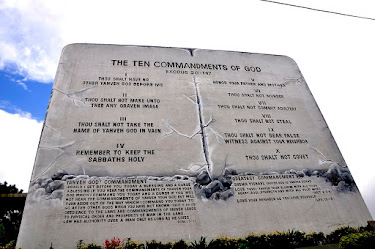As a young boy growing up in Baguio in the 60s and 70s, I would always wind up in this prayer garden with a few other little boys my age. Usually, it's at the end of a daylong "hunting trip" for small birds which we shot with our home-made rubberband slingshots--called palsi-it. I know it's not politically-correct to brag about such exploits today. But in my defense, no endemic bird populations were yet endangered in 1967. Add to this I must have been a cross-eyed little twerp back then because in reunion chats with friends 50 years later none of them seems to remember me ever hitting prey. I might have clipped one or two on the wing but not badly enough to ground the little critters who always managed to flay away.
Full to our stomachs on wild red berries, we would stretch out on the many outdoor pews in front of Saint Martin's statue, gazing up to the skies counting as many animal cloud shapes as we could recognize. It was a healing time, too, as we took stock of how many little cuts we had on our bare hands and legs, bushwhacking through thickets of talahib or runo--a local woody shrub with long bladelike leaves. A few crushed leaves of bitter marapait (local wild sunflower) was a little boy's first-aid kit. The juicy poultice applied to open cuts stung really bad but, believe it or not, instantly stopped any bleeding. Are you paying attention, Pfizer Laboratories?
So I felt a little sad for Saint Martin as I watched the transformation of his garden. I felt sorry for myself too for waiting this long to even get curious about who he was and what he did in life. Apparently, Saint Martin de Porres (1579-1639) was a Peruvian lay brother of the Dominican order. He was the illegitimate son of a Spanish nobleman and a woman who was a freed slave of African-Native American descent.
 |
| Although not among the superstars in the pantheon of Vatican saints, St. Martin de Porres is nontheless popular in Latin and North America, earning a panel in the glass-stained windows of St. Dominic's Church in Washgington, |
The supreme offer of self-sacrifice so touched the other monks that they decided to defy Peruvian law and made him take his priestly vows discreetly. This forced his personal ministry underground as he embarked on a daily struggle to keep a low profile in a cat-and-mouse game with church and government hierarchy.
Back in the day, no person of color is permitted to rise in fame. This proved difficult in his case because he made performing healing miracles so commonplace. He brought his healing outreaches to underprivileged communities who, having no money to give him, could not keep their mouths shut with thousands of eyewitness testimonies of his miraculous works. In time, even jealous white monks shed all pretenses of godliness and openly resisted his rise to prominence, calling him nothing but a celebrated black dog (I often wondered why there was a black dog standing beside his statue!).
You can say Saint Martin is the earliest voice of Black Lives Matter. He fearlessly broke quarantine rules during the Black Plague to care for colored communities. People of color showing symptoms of the bubonic plague were often corralled in medical concentration camps denied all forms of medication that were reserved for the white population.
It is said that Saint Martin endlessly went in and out those heavily-sealed human containments with some obvious divine intervention because locked iron gates flung open on his approach. The plague took a heavy casualty toll on whites just as it is said that hardly anyone succumbed to the pandemic in the rejected communities that Saint Martin visited.
To believe the accounts of his many other miracles--such as being engulfed in flames during prayer, bilocation or being in two places simultaneously--for some agnostics may be a bridge too far. But that a man named Martin de Porres actually lived is factual history. And after a long deliberative process in the cloistered innards of the Vatican, he was finally beatified in 1837 by Pope Gregory XVI and canonized as a saint on May 6, 1962 by Pope John XXIII. Interestingly, this beatification is recognized not just by the Roman Catholic church but also by the Lutheran Church and the Anglican Communion. He is assigned the feast day of November 3--my own father's birthday.
 |
| We lay on these stone pews in St. Martin's prayer garden after we had gorged on wild red berries that grew around the yard. Sadly these pews are gone. The garden iself is gone. |
If the Prayer Garden of Saint Martin de Porres had still been around today, it's straight where I'm headed to medidate and ponder some more. And to look if any of those wild berries were still around...
Note: Recently, I launched a YouTube channel and I featured some of this material in a short video, which you can watch by clicking the image link below:
NOTE FROM JOEL: Hi, folks! Recently, I started a YouTube channel which is called "Parables and Reason" It is kind of similar to this blog content-wise. You can check out my channel by clicking the link below:
Joel R. Dizon - PARABLES AND REASON
















